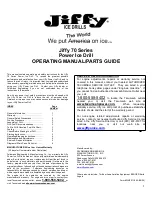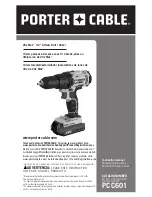
Safety Instruction
General Safety Warnings
For Electric Tools
Warning! Read all warnings and instructions.
Failure to follow the below warnings and
instructions may result in electric shock, fire or
serious injury.
Keep all warnings and instructions for future
reference.
The term "electric tool" refers to utility power-driv-
en (wired) electric tools or battery-driven
(wireless) electric tools in all the following
warnings.
1. Keep the workplace clean and bright. A disordered
and dark workplace can cause accidents.
2. Do not operate electric tools in an explosive
environment with flammable liquid, gas or dust.
Sparks generated from electric tools can ignite dust
or gas.
3. Keep children and bystanders away and operate
electric tools. The operator will lose control of the
tool if he is distracted.
1. The plug of electric tool must match with the socket.
Never modify the plug in any way. Do not use any
conversion plugs for electric tools that need to be
grounded. Unmodified plugs and matching sockets
will reduce the risk of electric shock.
2. Avoid human contact with grounded surfaces such
as pipes, heat sinks and refrigerators. If your body is
grounded, it will increase the risk of electric shock.
3. Do not expose electric tools to rain or humid
environments. Water entering the electric tool will
increase the risk of electric shock.
4. Do not abuse wires. Never use wires to carry, pull
the electric tool or pull its plug. Keep wires away
from heat source, oil, sharp edges or moving parts.
Damaged or entangled cords will increase the risk
of electric shock.
5. When using electric tools outdoors, use an external
cord suitable for outdoor use. The cord suitable for
outdoor use will reduce the risk of electric shock.
6. If it is unavoidable to operate electric tools in a
humid environment, a residual current operated
protective device (RCD) should be used. Using
RCD will reduce the risk of electric shock.
1. Stay alert, pay attention to what you are doing and
stay awake when operating electric tools. Do not
operate electric tools when you are tired, or when
you are responding to drugs, alcohol, or treatment.
Momentary negligence when operating electric tools
can cause serious personal injury.
2. Use personal protective equipment. Always wear
goggles. Safety devices, such as the use of dust
masks, non-skid safety shoes, safety helmets,
hearing protection and other devices under
appropriate conditions can reduce personal injury.
3. Prevent accidental start. Ensure that the switch is in
the off position when connecting the power supply
and/or battery box, picking up or carrying tools.
Putting a finger on a switch that has been turned on
or inserting a plug while the switch is on may cause
danger.
4. Before turning on the electric tool, remove all
adjustment keys or wrenches. Wrenches or keys left
on rotating parts of electric tools can cause personal
injury.
5. Do not stretch your hands too long. Always pay
attention to your footing and body balance. In this
way, the electric tool can be well controlled in
unexpected situations.
6. Dress appropriately. Do not wear loose clothes or
accessories. Keep clothing, gloves and hair away
from moving parts. Loose clothes, accessories or
long hair may be caught in moving parts.
7. If devices for connecting with dust removal and dust
collection equipment are provided, make sure they
are well connected and used properly. Using these
devices can reduce the danger caused by dust.
1. Do not abuse electric tools, use appropriate electric
tools according to the purpose. Choosing a properly
designed electric tool will make your work more
efficient and safer.
2. If the switch cannot turn on or turn off the power to
the tool, the electric tool cannot be used. Electric
tools that cannot be controlled by switches are
dangerous and must be repaired.
3. Before making any adjustments, changing
accessories or storing electric tools, the plug must
be unplugged from the power supply and/or the
battery box must be disconnected from the tool.
This protective measure will reduce the risk of
accidental starting of the tool.
4. Store unused electric tools out of the reach of
children, and do not allow people who are not
familiar with electric tools or those who do not
understand these instructions to operate electric
tools. Electric tools are dangerous in the hands of
untrained users.
5. Maintain the electric tools. Check whether the
moving parts are adjusted in place or stuck, check
the damage of the parts and other conditions that
affect the operation of electric tool. If damaged, the
electric tool should be repaired before use. Many
accidents are caused by poorly maintained electric
tools.
6. Keep the cutting tools sharp and clean. Well-main-
tained tools with sharp cutting edges are not easy to
jam and easy to control.
7. Use electric tools ~ accessories and tool bits, etc., in
accordance with the instruction manual, considering
the working conditions and the work to be
performed. Using electric tools for operations that
are inconsistent with their purpose may cause
danger.
8. In general workplaces, class II tools should be used:
if class I tools are used, protective measures such
as residual current operated protective devices and
isolation transformers with a rated residual
operating current of no more than 30mA should be
used in the electrical circuit.
9. Class II or III tools should be used in wet workplaces
or workplaces with good electrical conductivity, such
as on metal structures.
Note: the term “Residual Current Operated
Protective Device (RCD)” can be replaced by
the term “Ground Fault Circuit Interrupter
(GFCI)” and “Earth Leakage Circuit Breaker
(ELCB)”.
a) Workplace Safety
b) Electrical Safety
d) Use and Precautions of Electric Tools
c) Personal Safety
Summary of Contents for PED 02-10
Page 1: ...PED 02 10 ELECTRIC DRILL ...
























